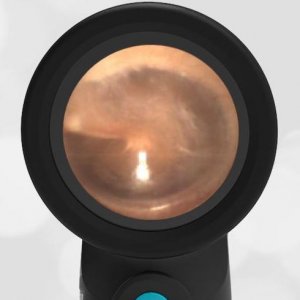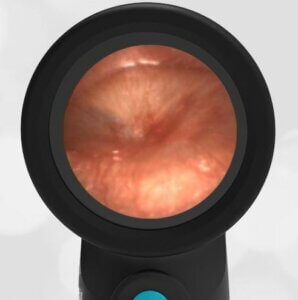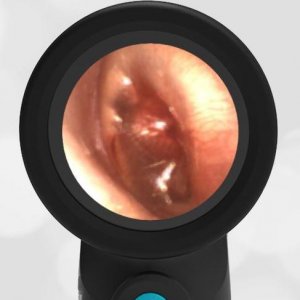
Bullous Myringitis
A five-year-old male child presents to the ED with ear pain and fever. His mother explains that the child’s symptoms started with a runny nose about 4 days ago. He then developed a cough and congestion. About a day ago, the child complained of ear pain and fever to 102.1 F. The mother has been treating with fluids, acetaminophen, and ibuprofen. Treatment transiently helps with the symptoms and provides comfort. The child’s older siblings had viral symptoms that resolved about a week ago. The child continues to eat and drink, but with less enthusiasm. A chest x-ray does not show pneumonia, and a rapid strep test comes back negative. This image of the child’s ear is obtained.
The child certainly has acute otitis media (AOM) and likely bullous myringitis.
Acute otitis media (AOM) is an infection in the middle ear space. This is the space behind the tympanic membrane. The infection causes inflammation that causes the eustachian tube (middle ear drainage channel) to become closed. The closed eustachian tube combined with inflammation causes fluid build-up in the middle ear. This causes bulging of the eardrum and is quite uncomfortable. Bullous myringitis may be considered to be a severe form of AOM where there is blistering on the tympanic membrane. In this case, there does appear to be blistering developing in the central part of the tympanic membrane, the pars tensa. Bulging along the periphery of the membrane is clearly visible, consistent with AOM. The blistering of the tympanic membrane can result in a hemorrhagic bulla as in this example.
Compare the images below. A normal ear, acute otitis media (bulging), and bullous myringitis (bulging with blistering).
- Normal Ear
- Acute Otitis Media
- Bullous Myringitis
Treatment is focused on providing pain relief along with treating the underlying infection. An anesthetic such as topical lidocaine can be introduced in the ear canal to provide timely pain relief. Treatment of the underlying infection is the same as for acute otitis media. For children that have frequent cases of AOM, ventilation tubes may be indicated.










































































































































































































